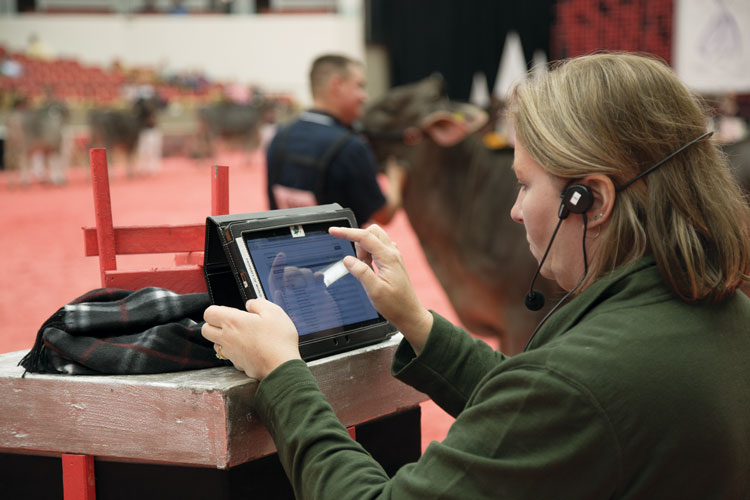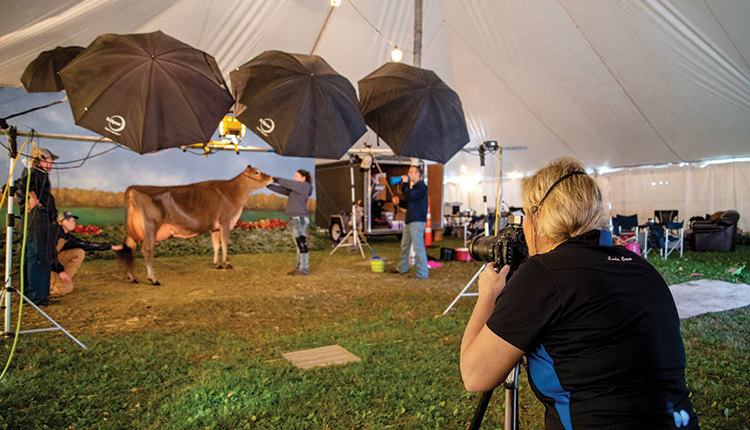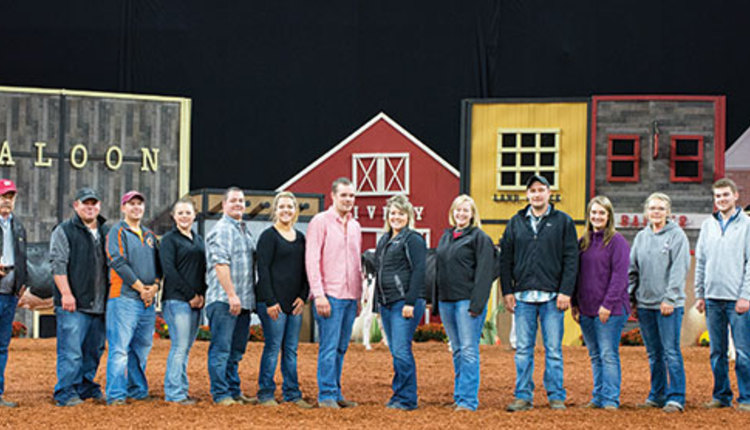The author farms with her husband and his parents at Ryan-Vu Holsteins, an 80-cow dairy in Fond du Lac, Wis.

Each year, close to 70,000 people from nearly 100 countries descend on Madison, Wis., during the first week of October for World Dairy Expo. However, not everyone who would like to can attend. Thanks to today’s improving technology, anyone can see the dairy cattle show results in real time and connect with World Dairy Expo on social media to receive messages about the results.
This connection is made possible by the Dairy Cattle Show system currently utilized by World Dairy Expo. Not only does this system enable real-time results, it has great benefits for dairy cattle exhibitors, show superintendents, and volunteers alike.
Laurie Breuch, World Dairy Expo dairy cattle show coordinator, has spearheaded the efforts since the system’s inception in 2012.
“Online results have been a part of the Expo website since 1999, just not as flexible and integrated as it is today. The new online Dairy Cattle Show system was designed, developed, and launched for the 2012 show, with new components and steady improvements added since then,” Breuch explained.
“World Dairy Expo was looking to enhance and integrate technologies to better manage its pioneered dairy cattle show management applications. Overall, we wanted to use today’s technologies to improve the cattle show functions to enforce security, obtain data, track changes, and produce outcomes that the future would demand,” she added.
The Dairy Cattle Show system is driven by online entries. Once the system is populated, World Dairy Expo works with the national breed associations to review entries for complete data, ownership, and junior member status. Then during Expo week, breed superintendents, their assisting superintendents, and volunteers visit each string on the grounds to verify which cattle are on the grounds. At that point, teams double check registration numbers, attached animal identification tags, tattoos, markings, and so forth, to ensure accurate entry information.
From binders to tablets
Kimberly Moucha, who has served as the Ayrshire superintendent for the last five years, commented “Prior to the new Dairy Cattle Show system, we used scanners in the showring to record the results. All data was manually entered, and updates required taking down the whole system. Now exhibitors, attendees, and those who can’t attend can see the results and watch the show online as the information is getting processed and released so much faster.”
Moucha added that the improved efficiency from a superintendent and exhibitor standpoint has been a huge plus. As opposed to carrying around huge binders filled with all the entry information and having to call the office during the cattle check-in process with questions, all information is available on the tablets and at the fingertips for those doing check-in.
“Exhibitors can enter online, and all the information is transferred and can easily be verified on the tablets right in the Pavilions,” explained Moucha. “When it comes down to show day, animals checked in and not checked in can be seen and called for as needed during the show, and placings are sent right up to the announcer’s table quickly following class completion.”
All in all, Moucha estimates the Dairy Cattle Show system has shaved approximately 15 minutes off of each class. Additionally, the system now tabulates the Premier Sire, Premier Exhibitor, and Premier Breeder of each show while it is happening. Finally, she feels that the ability to see how many cattle are entered and checked in prior to the show helps breed superintendents more accurately anticipate the time needs for their specific shows and plan accordingly.
Once animals are checked in by the superintendents and their teams, back tags are generated and distributed at the exhibitor breed meetings. According to Breuch, this is a very important tool that tracks every entry for each international breed show.
“All entries must arrive at the Hair Tent (ringside check-in) with the appropriate Expo-issued back tag. Then ringside show volunteers check the entries in for their respective class and organize the entries in cattle log order,” Breuch said.
“At the completion of a class, another team of ringside show volunteers records the class placings in order beginning with first place. They also record the best udder in cow classes and other special awards like production. The Dairy Cattle Show system is synced to update (within seconds) and display information for the announcer to present the top two juniors, bred and owned, and top three class winners.”
At the same time, Breuch explained the placings are populated to the Expo dairy cattle show results websites, ExpoTV productions for screen display, text message (for the top three), and social media (Facebook and Twitter for the champion classes). Finally, class winners are prepopulated through the system to their appropriate champion classes for easy check-in and placing later in the day.
It is easy to see how this system has become an integral part of World Dairy Expo’s international breed shows, while enabling rapid communication of results to those both on and off the grounds.
So, what are the keys to its success? Breuch said it all starts with exhibitors embracing this system for entries, and about 80 percent of exhibitors are utilizing the online system when entering. Moucha added that internet access at the grounds and expecially good Wi-Fi coverage throughout the grounds is of utmost importance.
“When we first started with the Dairy Cattle Show system, we experienced some connection issues when checking in cattle,” Moucha explained. “One of the other breed superintendents, Jon Rasmussen, and I did a coverage study on the grounds to locate connectivity dead spots so we could get better coverage to those areas. Also, the Coliseum now has its own wireless setup dedicated just for the Dairy Cattle Show system to ensure it runs smoothly.”
More in store
The system has evolved since its introduction in 2012. “Each year following the show, breed superintendents meet and discuss their needs and suggest improvements to the operation of the show, like additional reports or more data on a specific report to better manage their breed show entries,” Breuch said.
“Other updates have included a health check-in component to aid in recording electronic RFID (radio-frequency identification) entries, a dairy cattle and exhibitor search to allow attendees to search at a kiosk for cattle and/or exhibitors to pinpoint their stalling location on the grounds and text messages of class winners.”
Breuch said attendees can look forward to two new additions to the 2018 World Dairy Expo. Namely, the class-winning animal name and owner information will be displayed on ExpoTV and a railbird contest that will work with the texting and results functions of the Dairy Cattle Show.
Further down the road, Breuch is working with the Dairy Cattle Show development team on integrating stalling requests and creating an electronic map for breed superintendents and exhibitors.
Moucha said that the Dairy Cattle Show system has exceeded expectations so far and is poised to continue that trend. “Laurie and the Expo team were instrumental in taking our suggestions and integrating them into a system that not only increased efficiencies from a breed superintendent and exhibitor standpoint, but also enabled real-time results for everyone,” she concluded.










